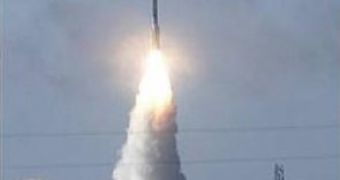On Tuesday, the U.S. military warned that a large spy satellite owned by the U.S. has lost power, is decaying its orbit and will most likely hit the Earth in the next two months or so. USA 193's size suggests that, as it will re-enter the atmosphere, it will not burn completely and some parts may end up of the surface almost intact. The situation is a double edged sword if I may, as it is not clear yet where the satellite will fall, meaning that it could pose danger to U.S. state security and the remnant debris may harm the population as well.
The function and purpose of this particular satellite is classified, thus analysts argue that it could be a spy satellite. USA 193, widely known as NRO launch 21, was sent into space on December 14, 2006, with the help of a Delta II rocket. Nearly a month after the U.S. reported that they had lost contact with one of their spy satellites, and by the look of how thing developed over time it seems that indeed they were talking about USA 193.
The satellite never reached its final orbit trajectory and started decaying orbit. US officials stated that the satellite contains some quantities hydrazine and beryllium, but speculations have even gone further suggesting that it could in fact contain a nuclear reactor that was supposed to power the vehicle with electric energy through a radioactive decay process.
Ever since last year, the U.S. military has been trying to develop a contingency plan to deal with the unscheduled satellite re-entry. The spacecraft was estimated to weigh about 4,5 tonnes and might contain a series of complex secret imaging sensors. The Pentagon declared the satellite lost in the early months of 2007 after the satellite's main computer suffered a total failure.
U.S. Air Force General Gene Renuart added in his statement on Tuesday that for the moment U.S. state secrets are safe from falling into the wrong hand, as it looks that the satellite will follow a re-entry trajectory that will take it over the regions of the North American continent, and they are collaborating with neighboring states in case the satellite will hit their territories.
Although the hydrazine substance used as fuel is considered a toxic chemical, the vehicle barely used any during its one month of functioning in space, meaning that it may offer the possibility of explosion during the re-entry phase, which could solve most of the U.S. concerns.
Back in 2006 when it was launched, a British amateur satellite watcher named John Locker shot a video showing that the satellite is probably somewhere between 3,9 to 4,9 meters in diameter. A weight approximation corroborated with data regarding its altitude, trajectory and location showed that the vehicle is currently at an altitude of 276 kilometers above the Earth's surface, and is losing about 50 meters in altitude every day.
Ted Molczan, another satellite tracker from Canada, says that its trajectory can be calculated while reaching an altitude of 95 kilometers, when it will enter Earth's atmosphere and start burning with a flame visible from the surface. The fall will take about 30 minutes before the satellite disintegrates and partially burns in the atmosphere. Molczan also said that, only in the last 50 years, more than 17,000 different man-made objects have executed re-entries and fallen towards the Earth's surface.

 14 DAY TRIAL //
14 DAY TRIAL //